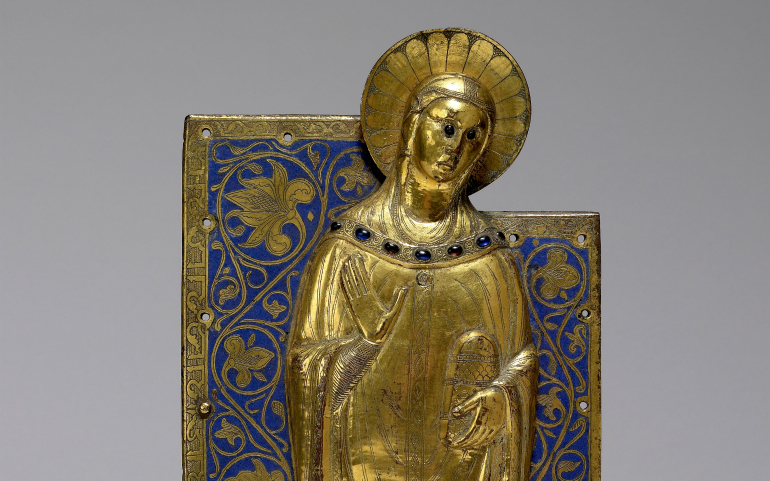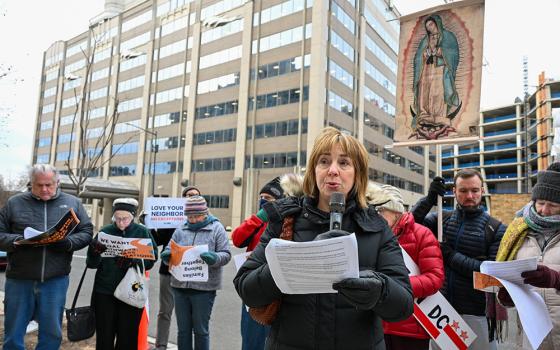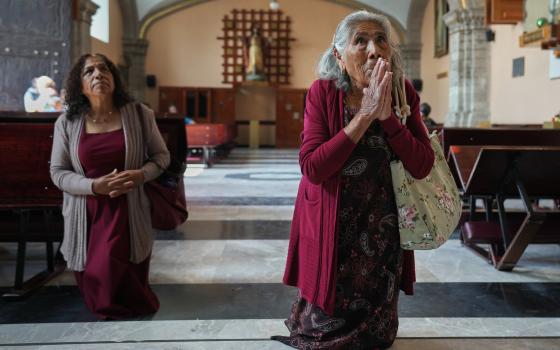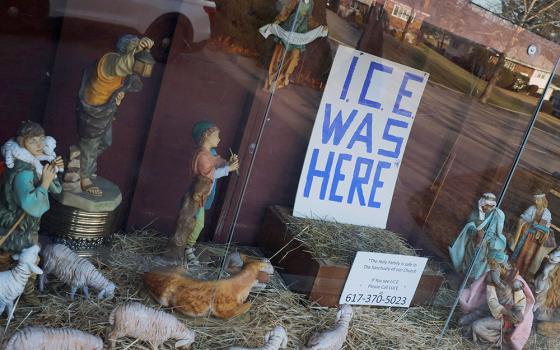
Detail of a French cross fragment of the Mourning Virgin, 1210-1220, champlevé enamel on copper with gilding and glass. (The Walters Art Museum)
To begin to understand the contours of recycling in the Middle Ages, it is necessary to forget a great deal about modern products and packaging. Many of today's goods are designed for single use: When milk, medicine or tissues are finished, one pitches the container in the trash with nary a second thought.
The contrast between present-day and the Middle Ages may be starkest with respect to paper, which runs less than a penny per page today. Before the birth of the printing press, scribes created books by hand on parchment; the manuscripts could be worth nearly their weight in gold. So when a manuscript outlived its usefulness to its owner, or when a better copy of the text was available, medieval people -- who had to be extremely wealthy to own even one book -- would recycle the book rather than toss it.
Scribes would scratch out text and illustrations from the parchment, and they would write another book on top of the old text. That collage formula, called a palimpsest, was a typical practice in the Middle Ages, which ran somewhat perpendicular to, and at times parallel to, contemporary notions of recycling. And it was often a combination of texts that carried specific religious implications.
"This is something that I think, to us, may be a little bit jarring that they would do that -- that they would have all of these time periods smushed together visually," said Lynley Anne Herbert, the Robert and Nancy Hall assistant curator of rare books and manuscripts at Baltimore's Walters Art Museum. "It's something that didn't bother people in the medieval period at all. They didn't mind having this amalgamation. Actually, it enriched things to have so many layers of history together."
Among the more than 20 objects, all culled from the Walters' collection, in the exhibit "Waste Not: The Art of Medieval Recycling" (through Sept. 18) is a gold Byzantine ring with an intaglio, or carving, of Pan. The "extremely pagan" depiction of the god, with pipes and goat legs, was reused about 1,000 years after it was made into the 12th-century ring, according to Herbert.
"They've embedded this into a very Christian ring with a Christian inscription on it," she said. "Anybody looking at this would know that this is not a Christian image."
In the 12th century, a Greek inscription was put around the ring: "God is my light and my savior, whom will I fear?" (Psalm 27:1)
"It's calling upon the Christian God's power to sort of overwhelm the power of the ancient world and to show that Christianity is in place," Herbert said.
By recycling the ancient material, the Christian buyer had a religious message in mind, essentially propagandist, about the triumph of Christianity over antiquity.
Other objects in the show incorporate several recycling efforts within the same object. A "Reliquary Panel of the Triumphant Christ" was an altar frontal in the 11th century depicting Christ, per Psalm 91, trampling a dragon-like snake.
In the 12th century, the panel and a companion -- which is now at the British Museum -- were removed and turned into end caps for a reliquary devoted to St. Oda.
In the 13th century, the reliquary was again taken apart, and the end caps were made into their own reliquaries with their own frames. The reliquary now has a golden and bejeweled frame, with stunning detail.
"You get these layers," Herbert said. "It's definitely a collage effect."
In addition to recycling art objects to bridge the historical and the contemporary, medieval artists and patrons recycled for other reasons. A prayer book created for Marie de' Medici in the 17th century featured illuminations that had been cut out of a 15th-century manuscript. Because the art of illumination was dying out at the time, the earlier art form was used to enhance the book.
"This is a queen; she can have anything she wants. It's not about, 'Oh. We have this thing lying around. Let's chop it up and stick it in here, because we can't afford to get a painter,' " Herbert said. "This is really about appreciating the quality of the craftsmanship and wanting to have it for yourself and to have it as a treasure."
Recycling could also play political propagandist roles, as in a gold belt buckle fashioned in the late fourth century, with a medallion depicting Constantius II (reigned 350-361). The emperor would have given the medallion as a token of appreciation to the belt owner, who set it alongside a coin honoring Faustina, the wife of emperor Antoninus Pius, in his belt. The latter coin came from two centuries prior. It was likely, Herbert said, that other coins would have appeared at regular intervals around the belt.
"It visually and literally links the current Byzantine emperor and the former emperor through the pieces," she said. "What this is is name-dropping. The person wearing this belt is like, 'Look. I'm connected to the current ruler, and through that person, I'm connected to all of these other famous people. This thing is super bling.' "
If one wasn't a queen with nearly infinite resources, one might have made tough decisions in the Middle Ages about what had to be reused in a new piece. If broken jewelry was lying around, the owner might melt the gold down and turn it into a new broach. Or if one ran out of parchment for a manuscript, a lesser book might be retooled.
When religious objects were involved, the calculus about what to preserve was altered, according to Herbert.
In general, she said, the medieval mindset was that everything that preceded Christianity necessarily built up to Christianity, and had to be in place for Christianity to arise. The Old Testament was a precursor of the New, and the past reinforced the present.
"A lot of the objects were seen as holy objects, so you don't want to necessarily destroy it," Herbert said. "There is a religious aspect to a lot of this as well. 'Oh. That image of that saint -- I don't want to melt that down. I can melt something that is Roman, because it's not my culture. Those people were pagans. But I don't necessarily want to melt down that altar frontal, because it's an image of an important saint. I don't want to get hit by a lightning bolt, so let's reuse it again.' "
There was also, she said, an aspect in medieval recycling of not being wasteful. Whereas the ancient Roman world was very rich, and the empire stretched from east to west with widely trafficked trade routes, the Middle Ages saw the division of that empire into smaller kingdoms. Resources that had been easy to secure in the ancient world, comparatively a consumer society, were much harder to acquire.
"I think that there is a very conscious reuse of things in the medieval era," Herbert said. "It is a very different moment."
Even certain religious objects would have been recycled. When there were multiple copies of a religious text, the worse copy might be retooled, or a version of a sacred text was used to create a better copy.
"To have the best thing for God, you have to sacrifice this other thing," Herbert said. "But it's OK, because it's for God."
[Menachem Wecker is co-author of the book Consider No Evil: Two Faith Traditions and the Problem of Academic Freedom in Religious Higher Education.]



